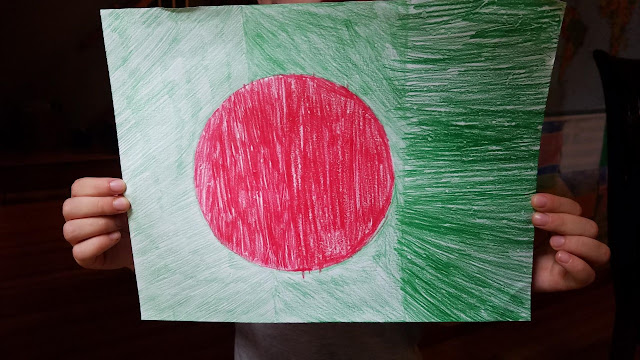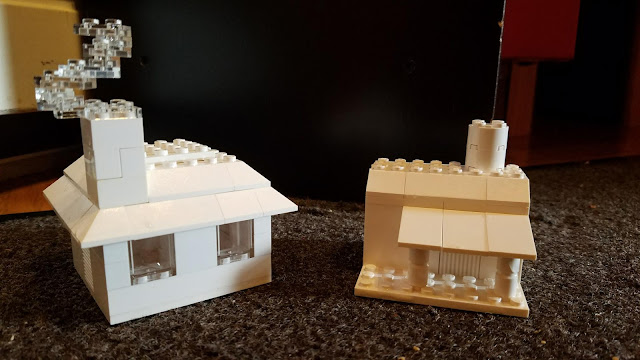Disclaimer: Some of the links in this post are affiliate links, meaning
that if you buy something using these links I receive a referral
commission at no additional cost to you.
Every summer, I get tired of policing my kids' screen time or negotiating
the precise number of minutes they have to play outside in order to get a
popsicle. So what works for us? The Educational Summer Vacation.
It's worked for us since 2011, learning about a different country every week. It give us some structure
and you never know when the little factoids we learn are going to come in
handy.
This week we learned about the country of Bangladesh!
Monday
Bangladesh is a country in southeast Asia. It's one of the most densely
populated nations, is home to the Bengal tiger, and if you look through your
clothes you'll see "made in Bangladesh" on several of the labels (it's the 2nd
largest textile exporter in the world.)
It's a poor country but also beautiful.
The kids found Bangladesh on our giant wall map (we have this one) and filled out their passports (free printable pages are here.) In their passports, they wrote what continent Bangladesh is on, what its capital city is, and what countries or bodies of water border it.
I read a book called Bangladesh In the Children's Own Words while the kids looked up the flag of Bengladesh and copied it.

|
| The flag has a solid green background, it just looks weird because my kids have a complex about being "fair" and they have to divide it up into different sections so everyone can color something. |
The last thing we did was watch the video Bangladesh from the Globe Trekker DVD series.
We've seen lots of videos from this series over the course of the last 11
years of The Educational Summer Vacation and gotten really attached to Ian
Wright, but for some reason this one had a different host and we were all a
little disappointed.
For dinner, we all had biryani, which was delicious. This
easy chicken biryani recipe
is technically from India, but it's a very popular dish in both places.
Tuesday
Non-Latin based languages still blow my kids' minds a little,
so today was a fun day learning all about Bengali, or Bangla.
We read B is for Bangladesh by Urmi Rahman and Prodeepta Das, and then talked about how important
language is to the country.
A long time ago, Bangladesh was called East Pakistan. The government center
was way over in West Pakistan (modern-day Pakistan) on the other side of India
and it discriminated against East Pakistan/Bangladesh pretty badly.
The final straw was when West Pakistan attempted to remove Bengali as an
official language,
and East Pakistan eventually fought for and won its independence as the
country of Bangladesh.
To learn to write the Bengali alphabet, we watched
this YouTube video and copied the letters.
We had to slow the video down to .3 playback speed so the younger kids could
keep up, and since listening to the audio at that speed is super-annoying, we
put on some Bengali music and listened to that instead. I liked
this song
and
this one
the most.
Bangladeshis divide the year into 6 seasons, which I printed out
from here
and had the kids attempt to match them. After they tried, we looked it up and
arranged them to the right order.
I then let them "type" in Bengali a little in order to see how each letter
combines so the words drop down from a single line at the top using
this website.
My 10-year-old had fun with it.
Wednesday
"Monsoon season," the rainy season, is from June through mid-October in
Bangladesh, and it's no joke.
80% of Bangladesh's annual rainfall happens during this season, and it's a
really, really wet country.
I asked the kids what problems might come from living in such a rainy place, and one of them is that things made out of wood (like bridges) rot really quickly when they're always wet.
One solution is living bridges: bridges literally made from the roots of
trees and careful cultivation.
My kids were really interested in that, so we found a video about living
bridges and how they're made here.
Then we filled the other side with water and used a piece of cardboard to
make "waves." They of course soaked the houses. Then we made a protective
mangrove forest along the shoreline out of brown pipe cleaners and leaves
from the yard, and tried it again. The houses stayed dry. (For a visual of
how this experiment works, see
this video.)
And now, a word about my teenagers.
I have the best teenagers in the world, who are willing to humor me both
for the sake of education and their younger siblings. They even went along with this activity, even if they did put their own spin
on it:
For a bedtime story, we read the picture book Iqbal and His Ingenious Idea by Elizabeth Suneby.
It's about a boy in Bangladesh who figures out a creative solution to help
his mom cook dinner during the rainy monsoon season.
Thursday
Bangladesh is home to the Sundarbans, one of the largest mangrove forests in
the world.
After taking an airboat tour through the mangroves in the Everglades in
April, the kids are pretty familiar with mangroves but there's always
something else to learn.
We watched
this video
about the Sundarban's protective influence against the rain, waves, and
flooding so common in Bangladesh, and then as an experiment we simulated a
storm with and without mangroves along the coast to see what would happen to
the houses on shore.
But first, we needed houses. I asked my older kids to look up common types
of houses in Bangladesh and build them out of Legos. (We have
this architecture set
that was pricey but totally worth it, especially if your kids are growing
out of "regular" Legos.)
While they were doing that, the younger kids and I made salt dough and made
a shoreline in a clear storage container. We placed the houses on the shore.
At the end of the experiment, the kids wanted to play with the wet, smooshy
walt dough and I think it may have been a mistake to let them do it inside.
Clean up took FOREVER.
Friday
Begal tigers live in the Sundarbans in Bangladesh, and we learned all about
them by reading Bengal Tiger by Nancy Dickmann.
Using
this tutorial
as inspiration, I printed out the blank outline of a tiger (no stripes!)
here and the kids painted theirs orange.
Then we put them inside cake pans and used pie weights (I didn't have
marbles) to make black stripes across the tigers.
While we waited for the tigers to dry, each kid looked up a picture of the
Sunderbans and drew it. We cut out the tigers and glued them to the
pictures. I think they turned out pretty well!

|
| At the bottom, it says Fig. 1: the pirate of the Sundarbans. |

|
| A surfer dude. Or surfr dood. Or whatever that is. |
Saturday
Dhaka, the capital of Bangladesh, is the most densely-populated city in the
word.
We watched a few videos (this
and
this) of the traffic in Dhaka, and I was hearing phantom horn honking for hours
afterward.
Click to Share:

We also watched
this 4K video
on the sights of Dhaka... no horn honking included.
Dhaka is also called the City of Mosques. About 89% of Bangladesh is
Muslim, so there are a lot of mosques to see there. We watched
this excellent video
for kids about what a mosque is, and
this one pointing out the various architectural features of a mosque.
We tested what the kids learned with a mosque crossword puzzle (page 9
here) and then we made paper bag mosques with
this tutorial.
I got to put my excessive scrapbooking paper stash to use, and I
loved how my 14-year-old cut his minaret out of musical note paper because
of the call to prayer.

|
| I think the dome of one mosque fell off. It's probably around here somewhere. |
While we were cutting and gluing, I suggested we put on some music from
Bangladesh and my 10-year-old said, "No, Mommy! Let's listen to the call to
prayer." So that's what we did.
It wasn't really related to today's activities, but we also read a picture
book called Twenty-two Cents: Muhammad Yunus and the Village Bank, a true story about someone who worked to bring a concept called
microlending to Bangladesh to lift people out of poverty.
It was an excellent read and led to a good conversation about the best
way to help people who need it.
During the week, I'd given the kids a few books set in Bangladesh to read on
their own, including the early chapter book Rickshaw Girl
by Mitali Perkins and The Unexpected Friend, a picture book about a Rohingya child from Myanmar in a Bangladeshi
refugee camp (heavy topic, but written in a totally kid-friendly way.)
Our family's "visit" to Bangladesh was full of fun learning experiences,
crafts, and music.
The kids may not remember every fact we covered, but this week has hopefully
expanded their horizons and reminded them there's a lot more to the world
than just what they see outside our front door.













6 comments:
I look forward to these posts all year! I really like how the tiger paintings came out.
Can't wait to see where you visit next!
This is awesome that you and your kids do this every summer! What a great way to learn about different countries and their cultures.
"What is Bangladesh?" was a correct response on Jeopardy last night. I got it right due to having read your blog!
Have you ever thought about marketing these lessons to homeschoolers? I mean, I don’t know if it would be worth it to you to do all the work it would take, but if you created a downloadable unit with all your plans, printable activities, recipes, book list, activities, etc. I bet you could sell it to homeschoolers looking for a creative, fun geography unit study. I homeschooled for years, and I know I never came up with anything nearly as creative as this, but this was the kind of thing I likes doing with my kids and I did sometimes buy unit studies. It would be perfect - you’ve got geography, history, art, writing, cooking, literature, and it works with all ages (the holy grail of homeschool lessons, let me tell you!). Throw in a couple of math worksheets and a baking soda volcano, and you’ve just about got a complete elementary curriculum here! (I’m only sort of kidding about that).
I have no idea whether you would have any interest in doing that, but I think that what you’ve created for your kids over the years is really special and valuable. Your kids are lucky, and you should be proud of your work.
Really relishing the surfer dood tiger! And the others are all great too. I hope you do make a HS curriculum out of this!! It'd be great for you to get some monetary reward for all the exhausting hard work you do!
Katie: Doing this kind of stuff with my kids is one of my side passions, and I'm afraid to monetize it and make it into work. I'm not a homeschool mom, I just play one on the Internet. (Also, we did do a baking soda volcano one year... it did not go well.)
For now I'm focused on what a great thing it is for the kids, and now I have proof: my teenagers have been saying for years that almost every week someone mentions an obscure location/historical fact/exotic animal and they're like "I know what/where that is!"
Post a Comment